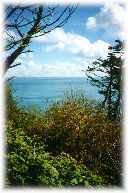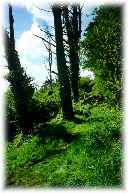![]()
![]()
STATUS
This has been a Trust reserve since 1974 when it was presented by Mrs Leach.

KEMYEL CREASE
| CLASSIFICATION
STATUS This has been a Trust reserve since 1974 when it was presented by Mrs Leach. |
 |
TYPE OF HABITAT
Terraced plantation on old bulb fields covering 2.4ha.
ACCESS
Grid Ref: .SW 460 243
Via the Coastal Footpath only which through the reserve. It is a walk of 1.5km (1 mile)
from where the coast path leaves the road south of Mousehole.
 |
GENERAL DESCRIPTION The reserve is quite unusual as it consists of five acres of sloping, cliff woodland leading down to the rocky shore. It contains 121 small fields (known as quillets) formerly used for bulb and potato growing. Due to the steep gradient, terracing was essential to prevent erosion. A variety of conifers were planted as wind-breaks at the turn of the century. These have now created a dense canopy which has prevented the development of a shrub layer. |
SPECIES OF PARTICULAR INTEREST
Due to its cliff-top position there are numerous seabirds, such as fulmars and cormorants. However, the reserve also has its share of more common garden birds. These, like the blackbird and robin, often search for the many beetles and caterpillars found here. Butterflies include the small skipper and marsh fritillary. Conifers are the dominant species of tree including Monterey cypress and Monterey pine. There are single specimens of ash and oak with a few beech and sycamore. An avenue of horse chestnuts runs through the wood and a variety of exotic plants have been introduced in the past including hydrangea and fuchsia. The ground flora is rather sparse due to the dense shade; only ferns growing successfully. However, fairly typical woodland plants such as herb robert, germander speedwell, penny-wort, cleavers, sorrel and black bryony are present. The reserve is rich in fungi and in the summer and autumn it is worth looking out for the unusual earth star fungus found on the ground. It is pale brown and darkens with age. The outer layer peels back forming a star shaped pattern on the ground.